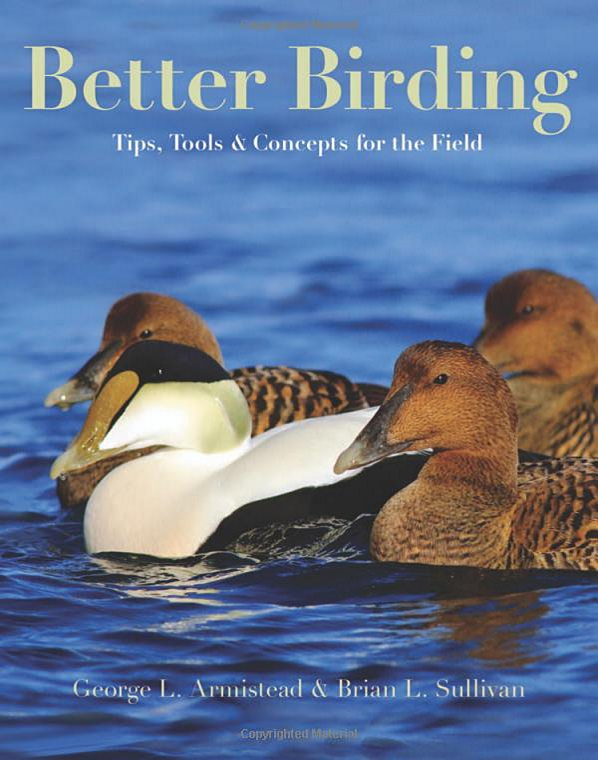Recensies
Better Birding - Tips, Tools & Concepts for the Field
14 februari 2016 · Yoav Perlman · 4577 × bekeken
George L. Armistead & Brian L. Sullivan 2015. Princeton University Press, Princeton & Oxford. 318 pp, numerous colour photographs and maps. Price: € 26,95.
With birding as a hobby increasing its popularity worldwide, there is a growing need from amateur birders to improve their birding skills. Obviously, birding skills are developed mainly in the field, but introductory reading material to the beginner is important. This book attempts to provide material for those who intend to improve their birding skills. But it is certainly not only aimed at beginners, but at keen birders as well.
The book begins with a brilliant introduction. Make sure you read it! I really didn't want it to end. It is written in such an appealing language, with good humour and lots of interesting and cool stuff about birding. It mainly describes the authors' point of view on how to become a better birder. The personal qualities of both authors, George Armistead and Brian Sullivan, as top-class field birders, writers and mentors, are evident it the introduction. I found the sections about moult (or molt...) and about using playback especially entertaining. The authors promote from the very beginning an interesting approach to birding, that combines hardcore scrutiny of single feather tracts, with more 'holistic' views and ideas about birds and birding. And I think they succeed in this combined approach quite well.
The species groups / families accounts are full of varied information. They combine introductory information about natural history, taxonomy and other general information that is useful for identification, comparing different species in the group or family. For example, the curlew section 'Natural History Note' gives useful information about why their bills are curved, and about sex-related size differences. Then come the species accounts. The book offers lots of information about jizz, behavior, distribution and movements. This recent focus on 'holistic' views of birds rather on magnifying-glass scrutiny of emarginations and primary tips is somewhat of an American trend. Kevin Carlson and Dale Rosselet's excellent Birding by Impression (Peterson Field Guides 2015) is another fine example for this approach.
But this book is not only about story-telling. It does get into some hardcore ID issues, including variation in American Black Duck x Mallard hybrids, and differences in wing formula of Western, Cassin's, Tropical and Couch's Kingbirds, complete with emarginations. The authors also focus attention on differences in vocalizations between species, yet most of these accounts use the old-fashioned 'pseeee' phonetic spell-out that is often pretty frustrating, especially for amateurs. In the introduction the authors promise frequent links to specific recordings in the Macaulay Library archive. However I feel that the links provided to ML files are too few and this fantastic database should have been more heavily referenced.
The images in the book are truly superb - I searched hard and couldn't find even one image that is not of top quality, and demonstrates well the points in the image caption. The process of selecting images for this book must have been exhausting, especially for the plates comparing similar species in identical postures. Not for every group, but for many, beautiful composites of small images from different angles and in different plumages are provided. The authors must have been inspired by the Crossley ID Guides. I found these composites very useful in most cases.
The book deals with a total of about 100 species divided into 24 groups. The authors chose these species and groups, but avoided other groups that are well-covered by other books, such as warblers. However, I would love to see a proper reference about Empidonax flycatchers that sadly are not represented here. The order in which the group and family accounts are organized is a little odd, with several backwards and forwards away from familiar systematic order (e.g. godwits, sparrows, wrens, Accipiters, rosefinches and swifts). Some species are grouped according to taxonomic relatedness (e.g. cormorants and divers), while in other examples species are grouped according to ecological niche or habitat preference (e.g. Aerial Insectivores). I found this slightly confusing.
This book was written primarily for American birders, and some sections are of little relevance to European birders, for example marsh sparrows and small wrens. However, many sections are an important reference for European birders, because they include Old World species that occur as vagrants to ABA region. The pipits section has very useful information about separation of American and Siberian Buff-bellied Pipits. The Atlantic gadfly section is very interesting too, and sums up nicely years of experience learned on pelagic trips off the East Coast. For this reason, I recommend this book to both keen and amateur European birders. The professionals will always appreciate high-quality analysis and presentation of new evidence, while the beginners can appreciate the very informative and guided approach offered by the authors. I believe that the information given in this book can make birders better.
Yoav Perlman
Discussie
Gebruikers van het forum gaan akkoord met de forumregels.

